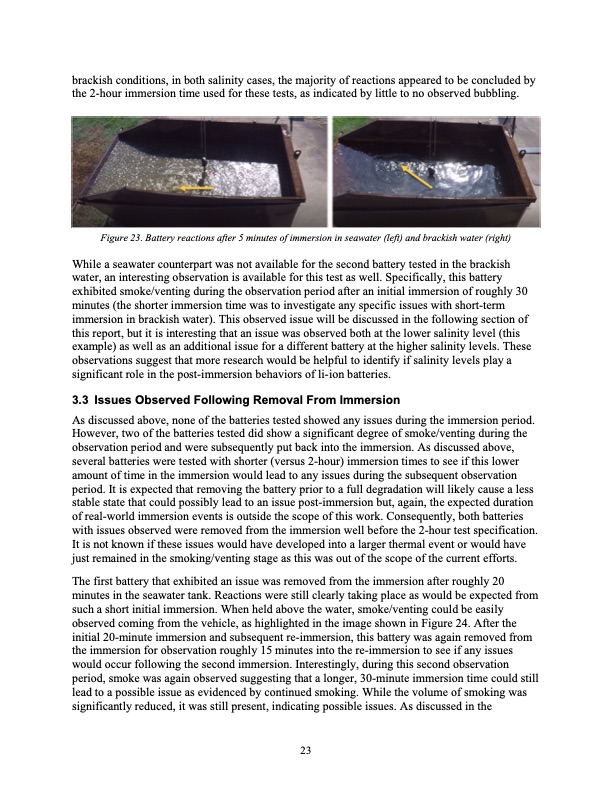
PDF Publication Title:
Text from PDF Page: 027
brackish conditions, in both salinity cases, the majority of reactions appeared to be concluded by the 2-hour immersion time used for these tests, as indicated by little to no observed bubbling. Figure 23. Battery reactions after 5 minutes of immersion in seawater (left) and brackish water (right) While a seawater counterpart was not available for the second battery tested in the brackish water, an interesting observation is available for this test as well. Specifically, this battery exhibited smoke/venting during the observation period after an initial immersion of roughly 30 minutes (the shorter immersion time was to investigate any specific issues with short-term immersion in brackish water). This observed issue will be discussed in the following section of this report, but it is interesting that an issue was observed both at the lower salinity level (this example) as well as an additional issue for a different battery at the higher salinity levels. These observations suggest that more research would be helpful to identify if salinity levels play a significant role in the post-immersion behaviors of li-ion batteries. 3.3 Issues Observed Following Removal From Immersion As discussed above, none of the batteries tested showed any issues during the immersion period. However, two of the batteries tested did show a significant degree of smoke/venting during the observation period and were subsequently put back into the immersion. As discussed above, several batteries were tested with shorter (versus 2-hour) immersion times to see if this lower amount of time in the immersion would lead to any issues during the subsequent observation period. It is expected that removing the battery prior to a full degradation will likely cause a less stable state that could possibly lead to an issue post-immersion but, again, the expected duration of real-world immersion events is outside the scope of this work. Consequently, both batteries with issues observed were removed from the immersion well before the 2-hour test specification. It is not known if these issues would have developed into a larger thermal event or would have just remained in the smoking/venting stage as this was out of the scope of the current efforts. The first battery that exhibited an issue was removed from the immersion after roughly 20 minutes in the seawater tank. Reactions were still clearly taking place as would be expected from such a short initial immersion. When held above the water, smoke/venting could be easily observed coming from the vehicle, as highlighted in the image shown in Figure 24. After the initial 20-minute immersion and subsequent re-immersion, this battery was again removed from the immersion for observation roughly 15 minutes into the re-immersion to see if any issues would occur following the second immersion. Interestingly, during this second observation period, smoke was again observed suggesting that a longer, 30-minute immersion time could still lead to a possible issue as evidenced by continued smoking. While the volume of smoking was significantly reduced, it was still present, indicating possible issues. As discussed in the 23PDF Image | Li-Ion Battery Pack Immersion Exploratory Investigation

PDF Search Title:
Li-Ion Battery Pack Immersion Exploratory InvestigationOriginal File Name Searched:
dot_57013_DS1.pdfDIY PDF Search: Google It | Yahoo | Bing
Product and Development Focus for Salgenx
Redox Flow Battery Technology: With the advent of the new USA tax credits for producing and selling batteries ($35/kW) we are focussing on a simple flow battery using shipping containers as the modular electrolyte storage units with tax credits up to $140,000 per system. Our main focus is on the salt battery. This battery can be used for both thermal and electrical storage applications. We call it the Cogeneration Battery or Cogen Battery. One project is converting salt (brine) based water conditioners to simultaneously produce power. In addition, there are many opportunities to extract Lithium from brine (salt lakes, groundwater, and producer water).Salt water or brine are huge sources for lithium. Most of the worlds lithium is acquired from a brine source. It's even in seawater in a low concentration. Brine is also a byproduct of huge powerplants, which can now use that as an electrolyte and a huge flow battery (which allows storage at the source).We welcome any business and equipment inquiries, as well as licensing our flow battery manufacturing.| CONTACT TEL: 608-238-6001 Email: greg@salgenx.com | RSS | AMP |